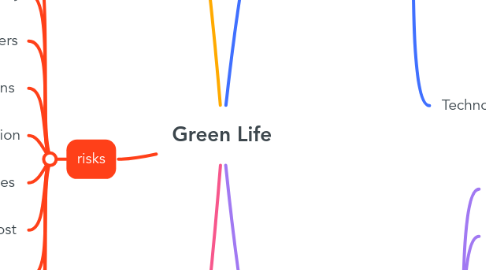
1. Feasibility
1.1. Market Analysis
1.1.1. Demand for health and natural products.
1.1.2. Increasing health trends among consumers.
1.1.3. Main competitors and available opportunities.
1.2. Cost Analysis
1.2.1. Development costs (software, design, promotion).
1.2.2. Shipping and distribution costs.
1.2.3. Cost of infrastructure (storage, supplies).
1.3. Target Audience Analysis
1.3.1. Age groups (youth, families, the elderly).
1.3.2. Customer preferences and purchasing behaviors.
1.4. Return analysis
1.4.1. Sources of income (subscriptions, individual sales, partnerships).
1.4.2. Calculate expected profits.
2. risks
2.1. Legislations and Laws
2.1.1. Laws on health and natural products may vary from country to country, and you may have difficulty complying with health and regulatory standards.
2.2. Quality and credibility
2.2.1. Healthy and natural products may face problems related to their quality or health effects, which may affect the company's reputation.
2.3. Trust and credibility with customers
2.3.1. Building trust with customers can be challenging, especially with products that directly affect their health.
2.4. Logistics challenges and supply chains
2.4.1. You may have problems delivering health products on time, especially if the products are delicate and need special storage conditions.
2.5. Intense competition
2.5.1. The market is crowded with applications and companies that offer healthy and natural products, making it more difficult to stand out.
2.6. Changes in customer preferences
2.6.1. Customer preferences can change quickly, and you may find it difficult to keep up with these changes.
2.7. Pricing and cost
2.7.1. If prices are too high, you may find it difficult to attract customers, and if they are too low, they may affect profits.
2.8. Security & Privacy
2.8.1. The app may face challenges related to the protection of sensitive customer data.
2.9. Technical challenges
2.9.1. Technical problems in the app may lead to a bad user experience, such as malfunctions or slowness.
2.10. Expansion and Management
2.10.1. Rapid expansion may cause stress on the team or resources, affecting the quality of service.
3. Needs
3.1. Quality certificates
3.1.1. Obtaining certificates from the approved bodies to ensure the quality of products (such as organic or natural products).
3.2. Health licenses
3.2.1. Compliance with laws and legislation related to food and health products in the countries where the application will operate.
3.3. Application Development
3.3.1. Develop a simple user interface with a premium user experience that focuses on customizing packages based on customer preferences.
3.3.2. Control panel for application managers to manage content, customers, and sales.
3.4. Inventory Management System
3.4.1. Integration with suppliers and real-time inventory tracking.
3.5. Contracting with suppliers
3.5.1. Build a network of reliable suppliers who provide high quality healthy and natural products.
3.6. Shipping Services
3.6.1. Contracting with local and international shipping companies to deliver products quickly and efficiently.
3.6.2. Follow up shipments and provide order tracking service for users.
3.7. Funding
3.7.1. Securing the capital required for application development, marketing and inventory building.
3.7.2. Search for investors or obtain loans to cover initial costs.
3.8. Human cadres
3.8.1. Development Team
3.8.2. Marketing Team
3.8.2.1. Specialists in digital marketing for campaign management and data analysis.
3.8.3. Logistic Team
3.8.3.1. Responsible for coordinating with suppliers and following up on inventory and shipments.
3.8.4. Customer Support Team
3.8.4.1. A team specialized in customer support to solve their problems and respond to their inquiries.
3.9. Technology
3.9.1. An artificial intelligence system to analyze user preferences and make personalized recommendations.
3.9.2. An effective subscription management system that allows users to easily edit and select.
4. Requirements
4.1. User Interface (UI) and User Experience (UX)
4.1.1. Design an attractive and easy-to-use interface with improved browsing experience and ease of purchase.
4.2. Payment gateway
4.2.1. Integrate a secure and easy-to-use payment system that supports various payment methods such as credit cards, PayPal, and digital wallets.
4.3. Subscription System
4.3.1. The development of a subscription management system enables users to choose the frequency of delivery (monthly, weekly, daily) and modify their subscriptions as needed.
4.4. Notification system
4.4.1. Send notifications to users about new shipments, offers, or product updates.
4.5. Integration with the inventory system
4.5.1. Inventory tracking
4.5.2. Order Management
4.5.3. Supply to avoid product shortages
4.6. Reports and Analysis
4.6.1. Management dashboard showing reports on subscriptions, sales, and user behavior.
4.7. Legal and regulatory requirements
4.7.1. Permits for the sale of health products
4.7.1.1. Ensure that the products comply with the health legislation of the country or region in which the service is provided.
4.7.2. Privacy Policies
4.7.2.1. Develop a privacy policy that is committed to protecting users' personal data, such as payment information and addresses.
4.7.3. Terms and Conditions
4.7.3.1. Develop clear terms of use that include information about subscriptions, cancellations, refunds, and more.
4.8. Selection of digital channels
4.8.1. Social media: such as Facebook, Instagram, Twitter.
4.8.2. Paid Ads: Such As Google Ads Or Social Media Ads.
4.8.3. Email marketing: sending offers or news of interest to customers.
4.8.4. Search Engine Optimization (SEO): To improve the visibility of the site in search results.
5. Benefits
5.1. Consumers
5.1.1. Rest and save time through a monthly subscription that meets their health needs.
5.1.2. Obtaining high quality products and reliable sources.
5.1.3. Save money by subscribing to discounted price packages compared to individual purchase.
5.2. Recurring and sustainable revenue thanks to the subscription model.
5.3. Building a community of health-conscious users
5.4. Improve loyalty by providing a personalized experience for each user.
5.5. Future expansion
5.5.1. Adding new products and services such as online health consultations or health analysis services (such as vitamin or gene testing).
5.5.2. Geographical expansion to other markets such as the Gulf or North Africa.
5.6. Exit strategy
5.6.1. The company can be sold or investments from larger companies in the field of health and nutrition.
